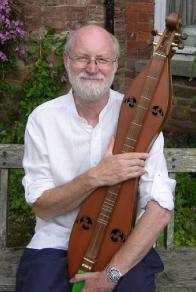"New" Epinette des Vosges
Some years ago I bought a rather sad epinette over the internet from France.
It is a small, Val dAjol-style instrument, but its length, number of strings (3 melody, 4 drone), the 6 fret and its decal or transfer flower decoration suggest an instrument from Flanders or Brabant in the North. A very similar dulcimer appears in the catalogue of a large scale epinette maker from the turn of the century called Coupleux, based in Turcoing/Lille right on the Belgian border in the North East of France.
The headstock appears to be have been machine-shaped from a hard, white wood such as beech or maple. The sides are softwood, probably spruce or pine. The top and back seem to be softwood also though I wondered about a softish hardwood such as fruit wood (cherry/apple/pear). The brass staple frets (running under the melody strings only) are arranged diatonically (but with a 6 fret) and attached directly to the soundboard. The nut is brass and the bridge hardwood. Overall length 25 (64mm), width 3 (8mm) tapering to 2 (5mm), depth 1 (2mm), VSL 18 (47.5mm). Seven dulcimer/piano pin style tuning pegs.
Unfortunately, the body was significantly distorted and hence unlikely ever to be strung, so I asked local expert dulcimer builder John Crocker (John Henry of this FOTMD parish) if he might be able to make something of similar size. The idea was for me to be able to demonstrate what a dulcimer ancestor sounded like in my festival workshops.
Imagine my surprise when he came back recently with this marvellous re-creation, even down to the painted flower decoration! Structurally, it is identical, although the fret spacing was changed to improve intonation. We've experimented with a variety of tunings, alighting finally on chanters/melody strings in D, mid-drones in D, bass drones in G. Whole therefore plays in G, starting on the 3rd fret of the melody strings.
So far so fairly standard for smaller epinettes. My question is why the 6 1/2 fret, if this was the usual tuning? Or should we experiment with what is effectively a DAD tuning, starting on the open melody string?

